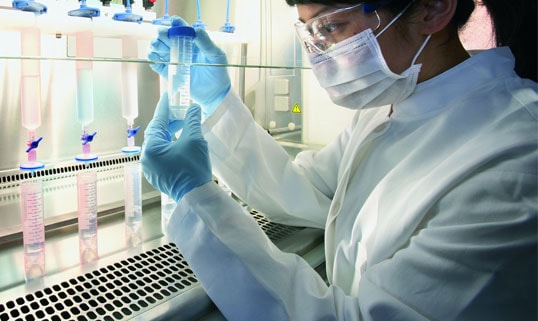CT26.WT-Fluc-Neo/eGFP-Puro
- Frozen / Standard (CL046-STAN) $ 2,100
Species: Mouse
Cell type: Colorectal Cancer
Transgenes: Firefly luciferase (Fluc) with neomycin resistance (Neo) for selection with G418 and enhanced green fluorescent protein (eGFP) with puromycin resistance (Puro) for selection with puromycin
Media: DMEM, 10% FBS, 1% Pen/Strep, 0.7mg/mL G418, 10μg/mL puromycin
Description: CT26.WT-mNIS-Neo/eGFP-Puro is a polyclonal population of the murine colorectal carcinoma cell line CT26.WT (ATCC® CRL-2638™) transduced with 1) LV-Fluc-P2A-Neo (LV011) encoding firefly luciferase (Fluc) cDNA under the spleen focus-forming virus (SFFV) promoter linked to the neomycin resistance gene (Neo) via a P2A cleavage peptide and 2) LV-eGFP-PGK-Puro (LV031) encoding enhanced green fluorescent protein (eGFP) cDNA under the spleen focus-forming virus (SFFV) promoter and the puromycin resistance gene (Puro) under control of the PGK promoter.
The lentiviral vector used is a self-inactivating (SIN) vector in which the viral enhancer and promoter has been deleted. Transcription inactivation of the LTR in the SIN provirus increases biosafety by preventing mobilization by replication competent viruses and enables regulated expression of the genes from the internal promoters without cis-acting effects of the LTR (Miyoshi et al., J Virol. 1998).
Cell Line Authentication: Authentication of the parental CT26.WT cell line was performed by short tandem repeat (STR) profiling with 27 STR loci. STR profiling of CT26.WT cells are verified and there is no interspecies cross contamination detected.
Recommended uses:
In vitro: This is a high Fluc/eGFP expressing cell line suitable for use as a positive control cell line in bioluminescence assays and fluorescence assays to verify luciferase or GFP expression respectively in your lentiviral transduced cells.
In vivo: CT26.WT cells form tumors post implantation into immunocompromised or syngenic Balb/c mice. The in vivo growth of these metastases can be monitored using bioluminescent imaging with D-luciferin substrate or optical imaging for GFP fluorescence.
Note: In-life imaging for GFP fluorescence is not recommended due to high background autofluorescence. Tissues may be harvested post mortem for analysis by conventional microscopy.
Publications that used associated reagents:
LV-eGFP-PGK-Puro (LV031): Shen et al. Immunovirotherapy with vesicular stomatitis virus and PD-L1 blockade enhances therapeutic outcome in murine acute myeloid leukemia. Blood. 2016. March 17: 127(11): 1449-58.
Cell Morphology: Low- and high-density cell morphology (200x)

Luciferase assay: 104-106 cells were placed in wells of a 96-well plate and 0.3 mg of d-luciferin was added to the indicated wells. The plate was immediately imaged using Perkin Elmer IVIS® Spectrum system.

Flow cytometry of CT26.WT-Fluc-Neo/eGFP-Puro (green) and control (grey) cells.

Bioluminescent images showing growth of a subcutaneous CT26.WT-Fluc tumor in an athymic mouse

107 CT26.WT-Fluc-Neo cells (Imanis Life catalog #CL043) were injected subcutaneously into the right flanks of female NCR athymic mice. Mice were imaged at day 0 on the day of cell implantation and subsequently at days 7 and 11 using a Perkin Elmer IVIS® Spectrum system, at 10-15 minutes post intraperitoneal injection of D-luciferin at 150 mg/kg. Tumor size was measured using calipers. Data from a representative mouse (ID#5815) is shown.

